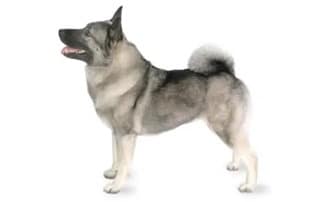
The Norwegian Elkhound is an ancient breed of dog originating in Norway. It is believed that this breed is the oldest of the Spitz type dogs. They are of medium size, with a sturdy, well-proportioned body, strong legs, and a thick double coat. The coat of the breed is thick and has a thick undercoat, dense upper-coat and long feathered legs, tail, and head. Common coat colors are grey, black and white, but other color variations include red shades and even blue-grey. They have an alert expression with a characteristic black mask around the eyes and muzzle. The ears are pointed and erect, and the nose is typically black. The breed was likely created through a variety of breeds, including the Greyhound, Great Pyrenees, and the German Spitz. What makes the Norwegian Elkhound so special is their true loyalty to their family. They are loving and protective, and will put themselves in front of danger to protect their family. It is also known for its courage, intelligence, strength, and fearlessness when dealing with predators, likely due to its role as a sled dog and hunter of large game. They also have a generous amount of energy and need plenty of daily exercise to be healthy and content.
Norwegian Elkhounds are known for their intelligence, playful nature, and loyal companionship. They have an even-tempered, patient, and gentle disposition, making them a great fit for families with children and other pets. Early training and socialization are essential to ensure they are well-behaved and can get along with other house pets. Norwegians love activity and exercise, with an average energy level that necessitates regular outdoor time. They’re active dogs and can be demanding of attention from their family. They should be walked daily and either a home or yard to play in. They can do well living indoors, with proper exercise, and do not make for noisy housemates. Their loyal disposition means they form strong bonds with their owners, so make sure to invest time in socializing with them on a regular basis to ensure their lifelong emotional health.
The Norwegian Elkhound is a regal and active hunting breed. They need a high-quality, nutrient-dense diet to keep them healthy and energetic. Owners should be aware of their pet’s caloric needs and provide them with a diet containing an adequate amount of animal protein, essential fatty acids, vitamins, minerals, and antioxidants. Regular physical activity will also help the Norwegian Elkhound stay fit and healthy. Responsible ownership includes ensuring that your pet receives annual veterinary check-ups, as well as regular grooming and teeth brushing. If you are considering adding a Norwegian Elkhound to your family, the best way to learn more about this breed is by visiting WayCanina. Here you will find detailed information about their feeding, nutrition, and grooming requirements, as well as different ways to ensure they are getting a healthy, balanced diet. Ultimately, the key to keeping your Norwegian Elkhound happy and healthy is by providing responsible ownership, regular exercise, and a nutritionally balanced diet.
The Norwegian Elkhound is a playful, sturdy, energetic breed of dog. Grooming for this breed is fairly minimal, but brushing is still essential and occasional ear cleaning and baths should be done as needed. They may be predisposed to certain health problems, such as hip dysplasia, so regular visits to your veterinarian are recommended. With proper care and attention, your Norwegian Elkhound can live a happy and healthy life.
They have a typical life expectancy of 12 to 15 years. By providing regular veterinary check-ups and preventive care, vaccinations, and a balanced diet and regular exercise, you can help this breed to live a long and happy life.
Are you considering getting a Norwegian Elkhound? Owning a dog is a big responsibility, and each breed comes with its own set of pros and cons. Make sure to do your research before taking the plunge. Check out WayCanina’s blog posts and articles to compare different breeds and learn more about a dog’s lifestyle and wellbeing.